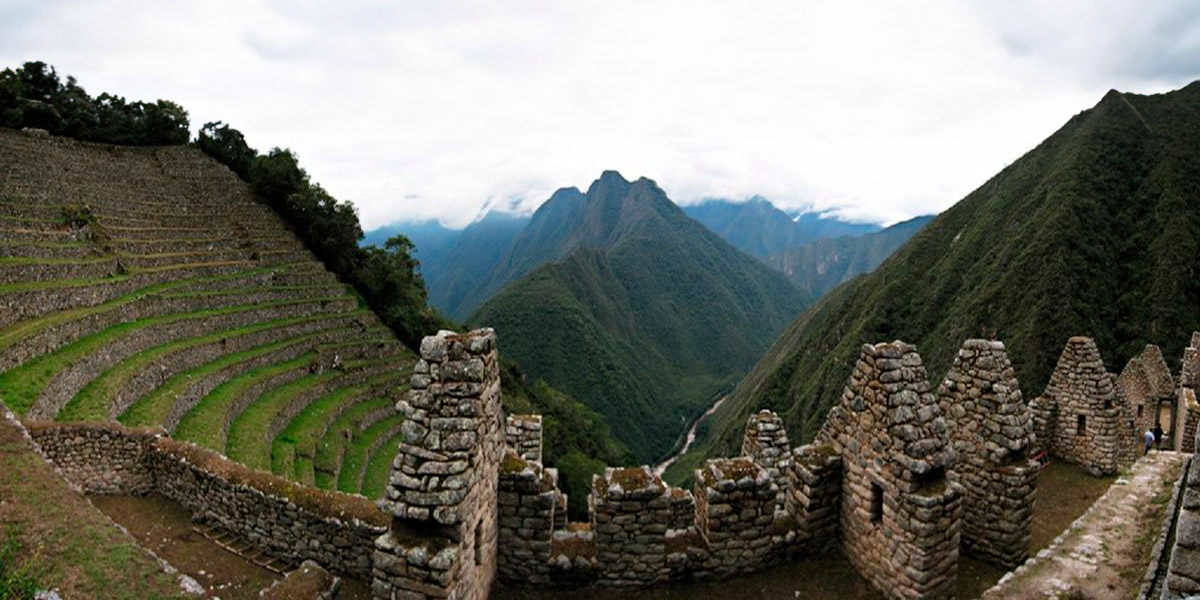Winay Huayna (Quechua means "always young") is an Inca ruin along the Inca Trail to Machu Picchu. It is built on a steep hill overlooking the Urubamba River. The site consists of upper and lower house complexes connected by a staircase and fountain structures. Above and below the houses, people built agricultural terrace areas, which are still visible.
Winaywayna is located on the Inca Trail route, 3.3 km in a straight line (straight line) south-southeast of Machu Picchu, between Puyupatamarca and Intipunku (the ‘Puerta del Sol’, entrance to Machu Picchu).
On foot, between Wiñaywayna and Machu Picchu are 7 km.
What is Wiñayhuayna?
It is a construction located near the citadel of Machu Picchu and facing the beautiful Urubamba River, discovered sometime between 1940 and 1942 by the Wenner Gren Scientific Expedition, led by Paul Fejos. In Quechua, Winaywayna means "always young". The site is located at 2,700 meters above sea level, that is, in a section where the Inca Trail has already descended in altitude.
The Wiñayhuayna ruins in Peru date back to the mid-15th century, built during the days of the mighty Inca Empire. They are one of the stops along the Inca Trail, and the exact purpose of the site is difficult to say. It may have been a spiritual or religious destination, or simply a place for the elderly or royalty to rest before reaching the end of the 26-mile journey to Machu Picchu.
The Winayhuayna ruins in Peru consist of upper and lower collections of Inca architecture, connected by stone steps that are laid out in graceful curves. The upper structures have a unique circular building, while below there is a collection of linear parapets with sharp peaks, irregular walls, and huge stone slabs with little space between them. The precarious staircase between the two levels embraces a long line of ancient fountains, often referred to as baths.
In addition to the architectural structures, the area is surrounded by an agricultural complex, terraced with extraordinary masonry of local stones.
Location of the Wiñay Huayna archaeological site
Winay Huayna is located on the Inca Trail route to Machu Picchu, in the region of Cusco, Peru. It is located about 2,650 meters above sea level, on a mountain slope that descends toward the Urubamba River. The site is located just 5 km from Machu Picchu, which makes it one of the last archaeological stops before reaching the famous Inca city.
Its strategic location allowed the Incas to control and make use of the terraced agricultural lands, as well as serve as a resting point for travelers who were moving toward Machu Picchu. Today, it is only possible to reach Wiñay Huayna on foot, either by doing the classic Inca Trail or the short 2-day version, which makes its visit a unique experience for hikers.
Wiñayhuayna architecture
Winayhuayna in Peru has a wonderful architectural, agricultural and religious design. To begin with, it is evident that it follows the Inca worldview of adapting the construction to the natural environment: Wiñayhuayna is perfectly attached to the side of a mountain, a really interesting way to build. This is so because the Andes of Cusco do not offer much flat soil for cultivation, so the Incas had to modify the slopes of the mountains to prepare them for agricultural activities. The site shows a large number of terraces that were used for agriculture, mainly potatoes, corn and coca. As was the rule in the Inca economic organization, the complex also has administrative areas, one at the top of the site and one at the bottom, which were interconnected by a stone staircase. In these offices, Inca officials planned and controlled all agricultural production, guided by the sun, the moon, and the rain, which marked the seasons; For example, the time of harvest was at the beginning of August, in today's calendar, because days later the coldest part of the year arrives in the region.
They kept an accurate account of production using quipus, a system of statistics that was made in long chains that were precisely knotted and tied to provide accurate information on agricultural resources.
Finally, there were large warehouses called qolqas, the places where crops were placed.
Enjoy the beauty of Andean nature in Wiñayhuayna
Wiñayhuayna in Peru shows incredible architectural beauty and majesty, and also really interesting historical and cultural information, but this is not all; It is located in the middle of the most wonderful landscapes of huge green mountains, the Urubamba river and the exuberant vegetation, and where you can also find free only Andean animals such as the famous llama and the Andean eagle, the condor. It is a place full of the strong flow of energy of the Andean nature, in a clean, healthy and relaxing environment. It is undoubtedly one of the highlights of the classic 4 day Inca Trail and the short 2 day Inca Trail.
Other ways to get to Machu Picchu include the Salkantay Trek 5 days / 4 nights.
How to get there?
According to many guides, the trip lasted about 3 days, following the Inca Trail, it began in the community of Piscacucho, although there are other ways to get to Wiñayhuayna in Peru, depending on the routes that the tourist takes, you can see beautiful communities like Cusichaca (km 82), Huayllabamba (km 88) Chachabamba (km 104).
The Wiñaywayna ruins are a stop along the Inca Trail, just 3 miles (4.7 km) from Machu Picchu. They are located a short walk from the campgrounds and are accessible between 8 a.m. and 8 p.m.
-
Walk to Wiñayhuayna
The Inca Trail to the Wiñaywayna ruins is like a walk through time. Something about it feels eternal. Named for the delicate orchids that dot the landscape, the name means "forever young" in the native Andean language of Quechua, a perfectly fitting name for such a timeless place.
Wiñay Wayna is located in a cloud forest, with fog coming and going, a lush dark green on the steep slopes of the mountains, and a constant waterfall casually leaning in the distance. Despite the beauty of the surroundings, it is almost always devoid of tourists, with the occasional Inca Trail campers the only people in sight. -
Recommendations
The tourist should know to bring some things that will be useful, such as pills against altitude sickness or soroche, sleeping bag, mosquito repellent and sunglasses.
Weather in Wiñayhuayna
It is warm and humid, with a ray of sunshine throughout the day and cool at night. The rainy seasons are from December to March.
Hiking tours to Machu Picchu
Many are the routes that take you to Machu Picchu, but none is like the Inca Trail Tours, the most famous pedestrian path in the Americas. After flying from the capital of Perú, Lima, you will arrive in Cusco to walk for four days along a path through forests and dense fog, millenary stone steps and discovering the ruins of ancient fortifications and Inca cities, and all the time enjoying majestic views.
INCA TRAIL TREKS
- 3 Day Inca Trail Tour
- Short Inca Trail
- 5 Day Inca Trail Hike
- Inca Trail Hiking Tour 4 Days
- Inca Trail and Amazon Rainforest
- 2 Day Inca Trail Hike With Camping
TOURS TO MACHU PICCHU
- Lima to Machu Picchu
- Machu Picchu Day Trip from Cusco
- 2 Day Sacred Valley to Machu Picchu
- Machu Picchu tour from Cusco
- Combo Sacred Valley to Machu Picchu
- Machu Picchu Honeymoon
If you want to visit Machu Picchu, we recommend you to book your Machu Picchu Tickets in advance, so you will enjoy your Vacation in Machu Picchu without any problem.









